What Causes Aggression in Alpacas?
If your alpaca shows aggression, it’s often due to confusing early human interaction that disrupts normal social development. Excessive handling or cuddling when young can make them see you as a herd member, leading to dominance struggles or Aberrant Behavior Syndrome. Isolation and lack of proper socialization also make them anxious and territorial. Hormones, especially in males, ramp up aggression during puberty. Understanding these causes helps you prevent and manage these behaviors more effectively. Keep exploring to learn how to handle this safely.
Key Takeaways
- Aberrant Behavior Syndrome caused by excessive human attention during growth leads to confusion and aggressive acts in alpacas.
- Hormonal changes, especially increased testosterone in males during puberty, trigger heightened aggression and territorial behavior.
- Lack of early socialization and isolation impairs herd skill development, causing frustration and aggression.
- Disrupted herd hierarchy, especially mixing adult males and females, leads to dominance struggles and aggression.
- Aggression signs include charging, biting, spitting, and invading personal space as dominance or warning behaviors.
Understanding Aberrant Behavior Syndrome in Alpacas
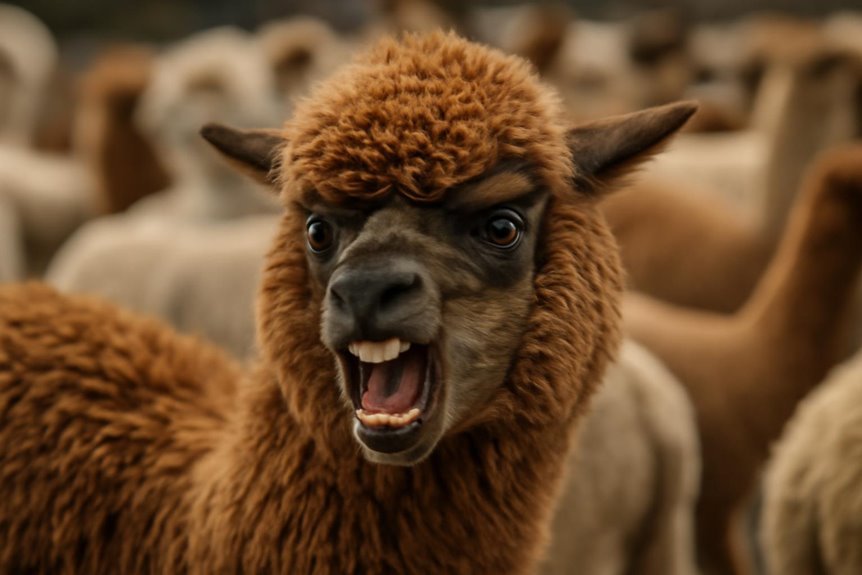
Although Aberrant Behavior Syndrome (ABS) in alpacas isn’t genetic, it develops when young alpacas receive too much human attention during significant growth stages, causing them to confuse humans with their own kind. This confusion leads to aberrant behavior syndrome, where alpacas fail to recognize appropriate social cues from humans. As they reach puberty, you might notice aggressive behavior, including charging, biting, and butting, which can be dangerous for handlers. ABS arises mainly from excessive human interaction and isolation from their peers, disrupting normal social development. To prevent this, it’s important to limit physical contact and guarantee alpacas grow up with companions of their own species. Understanding these factors will help you manage and reduce aggressive behavior linked to aberrant behavior syndrome in your alpacas.
The Role of Early Human Interaction
When alpacas receive too much human attention early in life, especially through excessive handling or cuddling, they can start to see humans as part of their herd. This early human interaction can confuse their natural behavior toward both humans and other alpacas. Alpacas that are bottle-fed and separated from their mothers often imprint on humans, missing essential social skills needed for proper herd interaction. As they reach puberty, especially males, hormonal changes combined with this misperception can trigger aggressive behaviors like charging or biting. Studies show that too much human contact during critical learning stages may cause alpacas to mistake playfulness for dominance, increasing aggression risks. To prevent this, it’s important to limit physical contact and prioritize socialization with other alpacas from an early age.
Impact of Imprinting on Aggression
Since imprinting causes young alpacas to bond too closely with humans, it can create confusion about their social roles as they grow. When crias are overexposed to human interaction, especially through bottle feeding and limited maternal care, they may mistake humans for herd members. This disrupts their natural behavior in llamas and alpacas, leading to challenges in recognizing their own species. As adults, these alpacas might show aggression, trying to assert dominance over humans they see as rivals, not caretakers. The lack of proper socialization with other alpacas during critical periods worsens this, as they don’t learn appropriate boundaries. By understanding imprinting’s impact, you can prevent aggressive behavior by ensuring young alpacas socialize adequately within their species early on.
Socialization and Herd Dynamics
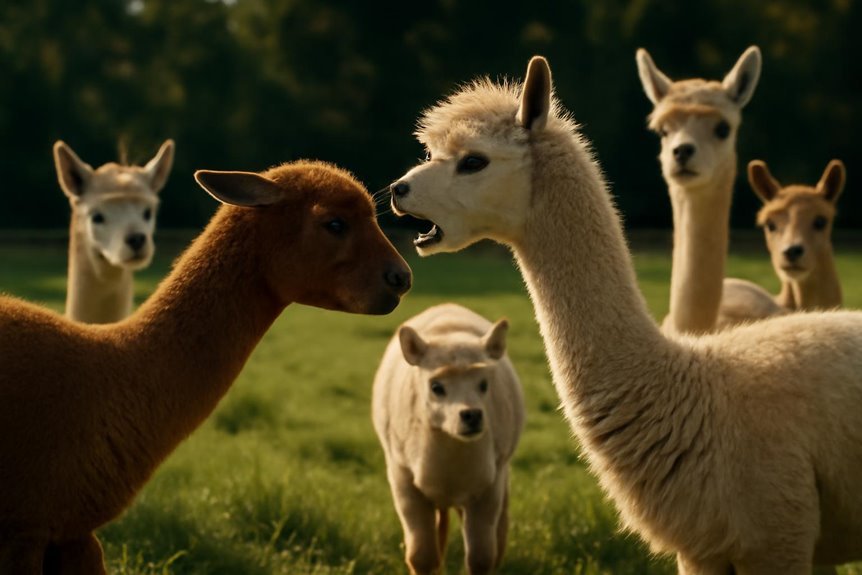
You’ll notice that alpacas need a clear herd hierarchy to feel secure and keep aggression in check. When they’re isolated or removed from their social group, it can cause stress and increase aggressive behavior. Understanding these social dynamics is key to managing their interactions effectively.
Herd Hierarchy Importance
Understanding alpaca aggression starts with recognizing the essential role of herd hierarchy in their social lives. Since alpacas are herd animals, having at least three individuals helps establish a clear social hierarchy, which is crucial for their mental well-being and stress reduction. Each alpaca has a role, typically led by an alpha, shaping social interactions and behavior. You need to maintain this structure to prevent agitation and aggressive behavior. Mixing adult males and females can disrupt the hierarchy, causing dominance struggles and potential harm. Social norms within the herd set boundaries for acceptable behavior, so when an alpaca doesn’t respect these, bullying or aggression can occur. By ensuring a stable social hierarchy, you support peaceful group dynamics and minimize aggression in your alpacas.
Effects of Isolation
Maintaining a stable herd hierarchy helps keep aggression in check, but isolation can quickly undo those benefits. When alpacas experience isolation, especially during their formative growth stages, their behavior often suffers. Without other alpacas to interact with, they miss out on essential social learning, leading to poor social skills and increased aggression. Young alpacas raised without peers may bond with humans but often see them as rivals, which can worsen aggressive behavior. Since herd dynamics rely on having at least three alpacas to establish social order, isolation causes stress and anxiety. This stress triggers agitation and misdirected aggression, as isolated alpacas struggle to navigate social cues. To minimize aggressive behavior, you’ll want to avoid isolating alpacas and guarantee they have proper herd companionship throughout their development.
Gender Differences in Aggressive Behavior
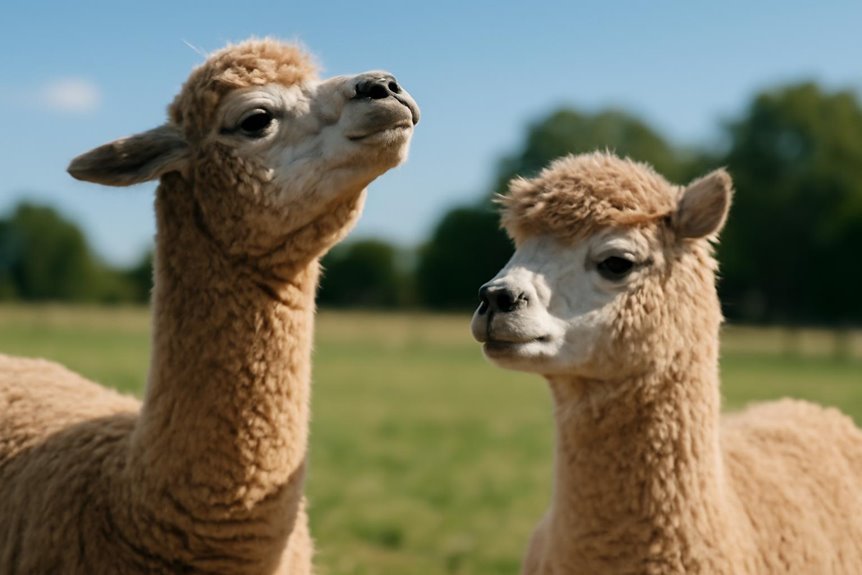
You’ll notice that male alpacas tend to show more physical aggression, especially during puberty when hormones kick in. Females can be challenging too, often through spitting or being difficult to handle, but their aggression is usually less intense. Understanding these hormonal and behavioral differences helps explain why males and females act differently in similar situations.
Male Aggression Tendencies
Though both male and female alpacas can show aggression, males tend to be more prone to aggressive behavior, especially during puberty when hormonal changes push them to assert dominance and defend territory. Understanding male aggression tendencies in alpacas and llamas is essential for managing their behavior effectively. You’ll notice:
- Male alpacas often display aggression through charging, chest-bumping, and sometimes attacking humans if improperly socialized.
- Castrating males before puberty can reduce aggressive tendencies but doesn’t always eliminate them.
- Excessive human interaction without proper socialization can lead to Aberrant Behavior Syndrome (ABS), where males view humans as rivals.
Female Behavioral Challenges
While male alpacas often show aggression through physical dominance and territorial behavior, female alpacas tend to express their challenges differently. You’ll notice female alpacas display aggressive behaviors like spitting and difficult handling, especially when feeling threatened or establishing dominance within the herd. Unlike males, females rarely charge physically but can be socially aggressive, particularly toward newcomers. Overcrowding or dominant individuals can increase stress and provoke conflicts among females, disrupting their social hierarchy. Maternal instincts also trigger aggression when they protect their young from perceived threats, including humans. To manage these tendencies, socialization and early training are vital. If female alpacas aren’t handled properly during their formative years, you might face increased spitting and challenging behaviors later on when interacting with them.
Hormonal Influence on Behavior
Hormones play a major role in shaping aggressive behavior in alpacas, especially when it comes to differences between males and females. You’ll notice that hormonal changes greatly impact male alpacas, making them more prone to aggressive behaviors. Here’s what you need to know:
- Males experience heightened aggression during puberty due to testosterone, leading to chest-ramming, charging, and territorial displays.
- Females show less severe aggression, like spitting, influenced by lower hormone levels.
- Castration before puberty can reduce aggressive behaviors in males by limiting testosterone’s effects.
Understanding these hormonal influences helps you manage and predict aggression better, ensuring safer handling and a calmer herd overall.
Effects of Isolation on Alpaca Temperament
When alpacas are isolated during key developmental stages, they often miss out on learning essential social skills, which can lead to aggression later on. Isolation prevents them from understanding herd dynamics and social hierarchies, causing behavioral issues that can persist into adulthood. Young alpacas raised alone may imprint on humans, confusing social roles and struggling to differentiate between alpacas and people. This confusion often results in aggressive behaviors as they mature. Additionally, lack of social interaction increases stress and anxiety, further contributing to aggression toward both humans and other alpacas. Early socialization is vital to help alpacas develop proper behavioral norms. Without it, they may exhibit inappropriate behaviors like territorial aggression or excessive friendliness, which can escalate as they grow older, posing challenges for their handlers.
Behavioral Signs of Aggression in Alpacas
If you notice an alpaca invading your personal space or suddenly charging, these could be clear signs of aggression. Understanding their body language helps you recognize when they’re uncomfortable or asserting dominance. Here are three common behavioral signs of aggression in alpacas:
- Charging or sudden lunges – this aggressive move signals a challenge or threat.
- Biting or mouthing clothing – often a misdirected social behavior indicating frustration or boundary testing.
- Spitting – a clear warning to back off, often used to establish hierarchy within the herd.
Pay attention to these behaviors, especially in males nearing breeding age, as over-friendliness can escalate into aggression. Recognizing these signs early helps you respond appropriately and respect their boundaries.
Preventative Measures for Aggression
Although alpacas naturally establish social hierarchies, you can prevent aggression by ensuring early socialization and consistent boundaries. Preventative measures for aggression start with early intervention—introducing young llamas or alpacas to their herd prevents isolation, which often leads to aggression. Avoid excessive cuddling or physical interaction so they don’t see humans as peers, reducing the risk of Aberrant Behavior Syndrome. Implement a strict hands-off policy during early handling and begin training within the first month of life to set clear boundaries. Providing companionship for young males is essential to prevent them from bonding too closely with humans, which can trigger aggressive tendencies later. By following these steps, you’ll help your alpacas develop proper social skills and maintain a peaceful herd dynamic.
Managing Aggressive Alpacas Safely
Since aggressive behavior in alpacas can escalate quickly, managing it safely requires prompt and consistent discipline. You need to address any signs of aggressive tendencies immediately to prevent escalation. Here’s how you can manage aggression effectively:
- Use verbal reprimands, light swats, or water blasters to deter alpacas when they invade your personal space.
- Maintain a strict handling protocol by limiting excessive physical contact and ensuring you’re not seen as a rival.
- Monitor behavior regularly to catch early warning signs and intervene with appropriate training or socialization.
Frequently Asked Questions
Why Are Alpacas so Aggressive?
You’ll find aggression triggers in alpacas often stem from improper handling techniques during their early life, which disrupts social development. If you don’t socialize them well, they might see you as a threat and act aggressively.
What Is the Angry Alpaca Syndrome?
You’ll learn that Angry Alpaca Syndrome causes angry behaviors due to disrupted alpaca psychology from excessive human contact and poor socialization. It makes alpacas act aggressively, especially during puberty, because they misinterpret social cues and boundaries.
How to Stop Alpacas From Fighting?
Like calming a stormy sea, preventing fights means managing your herd by keeping at least three alpacas together, setting feeding boundaries, socializing them early, and separating aggressive males to guarantee peaceful interactions and reduce tension.
How Do You Treat Berserk Syndrome in Alpacas?
When treating berserk syndrome, you’ll need immediate, firm discipline and early intervention. Socializing alpacas helps, but severe cases might require castration. Remember, treatment options are limited, and euthanasia could be necessary for dangerous animals.

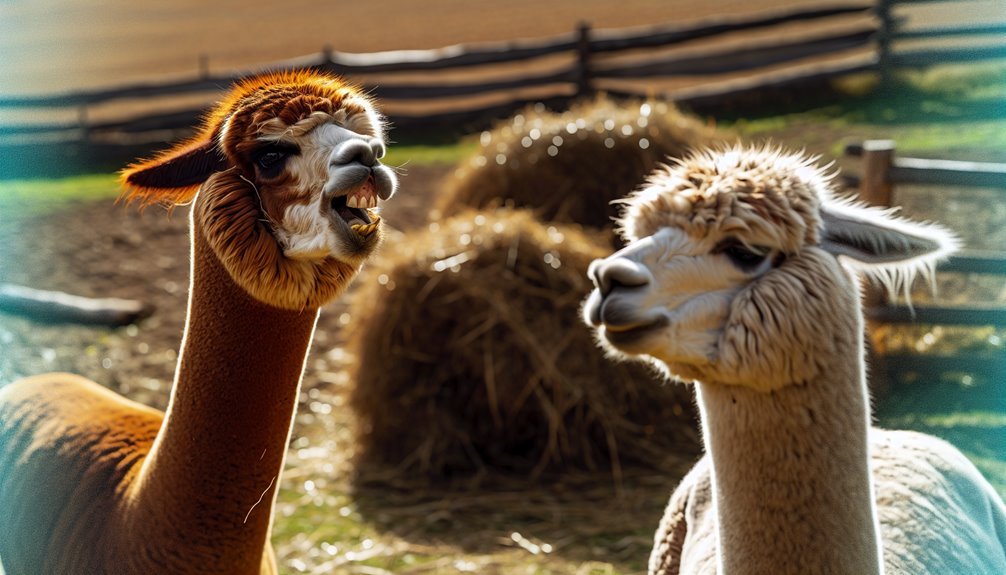
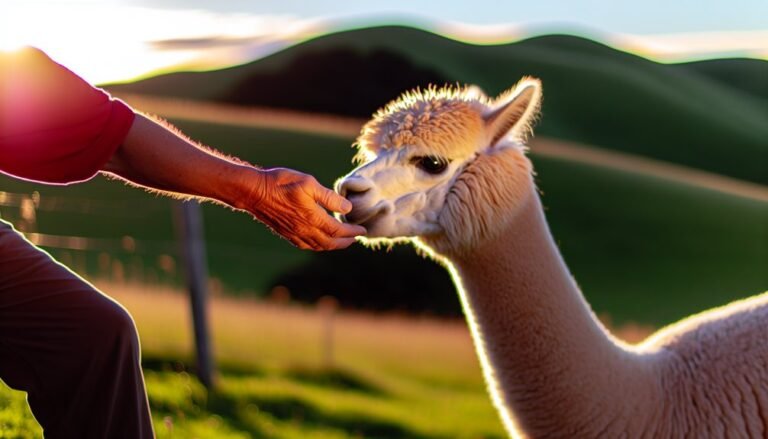

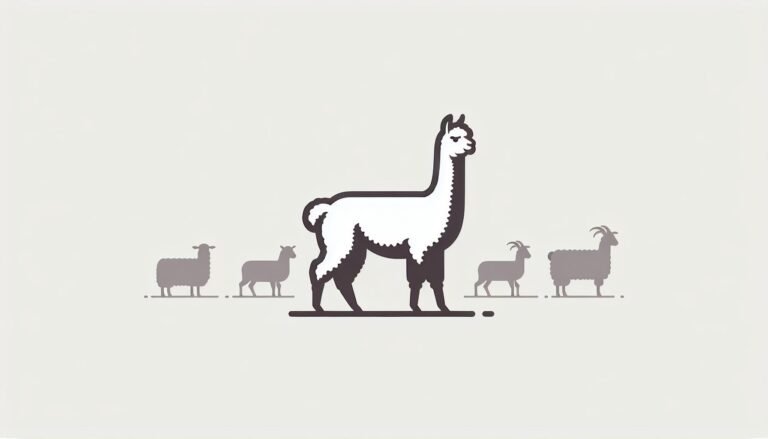

Our picks
Alpaca & Wool Felted Sole Inserts: Comfy Upgrade?
Best Alpaca Socks for Hiking: Ultimate Comfort and Durability on Trails
Best Alpaca Halter for Comfort and Control